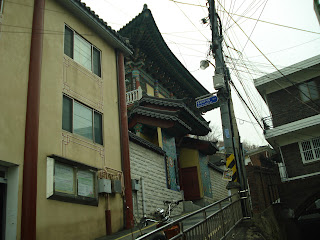Today I went to Seoul to do some Christmas shopping and some sightseeing. The first place I went to was Gilsangsa Temple(see pictures below) located in the northeast part of Seoul which is also the area where the majority of foreign diplomats live. Gilsangsa is located on the southern side of Mount Samgaksan so it is a bit of a climb to get to. It was amazing to be in a part of Seoul that is actually very quiet and peaceful.
Gilsangsa became a Zen Buddhist temple in 1995 so it is a relatively new temple. During the 1960's and the 1970's the building that is now the temple was a Yejeong. A Yejeong is a high class Korean style restaurant where politicians and military generals went to be entertained by Gisaeng (Korean geisha). The name of this particular Yejeong was Daewongak and was owned by the late Kim Yeong-han. She was a devote Buddhist and donated her land and restaurant in 1987 to Monk Pubjeong. Monk Pub Jeong was a zen master who decided to turn the restaurant into a place of worship. Monk Pub Jeong passed away at the temple on March 11, 2010 from lung cancer at age 78.
Although the temple only has a short history, it has done a lot to help local community and to help and to raise funds for the disabled, hungry children, poor children around the world, along with North Korean refugees. Programs are available which Koreans and foreigners can join. Programs include Buddhist education, meditation classes or short temple stays. The rest of the pictures of Gilsangsa can be found on Facebook.
The second place I visited was Seoul Iris Garden (see above pictures) which is also known as Seoul Botanical Garden located in the northern part of Seoul between Dobangsan and Suraksan mountains. It was opened June 7, 2009 and is a place I might venture back to see in the summer as the last of November is not exactly the best time to visit a botanical garden. The rest of the pictures from Seoul Iris Garden can be found on Facebook.
The last place I visited was Myogaksa Temple(see above pictures). Myogaksa Temple is located on the east side of Mt. Naksan in Seoul. First established by Monk Taeheo Hongseon in May of 1930, it has since expanded and underwent two renovations. The temple’s location was selected based on the principles of Feng Shui, which dictated that a temple built in its location would bring peace and comfort to Seoul’s residents. The Myogaksa Temple complex on Mt. Naksan accommodates a Deabul (Grand Buddha) Shrine, a Wontong Buddhist shrine, a Nakga preaching hall, Seokgulam Grotto, Sanshingak (Mountain Spirit Pavilion), and the Mae Buddha Statue. Deabul and Wontong shrines are two of the finest Buddhist architectural masterpieces. The Buddha statue, located inside the Seokgulam Grotto, was built around the ninth or early tenth century and has been designated a national cultural treasure. The Mae Buddha Statue, also located in this temple, was carved out of the rocky cliffs of Mt. Naksan and has been designated a cultural asset of the City of Seoul.
Since the 2002 FIFA World Cup when Myogaksa began operating its temple stay program, the temple has become a wonderful place where locals and tourists can escape the daily hustle-and-bustle of Seoul to experience the serenity of Buddhism. The rest of the pictures of Myogaksa Temple can be found on Facebook.
CHOENAN DUDE











No comments:
Post a Comment